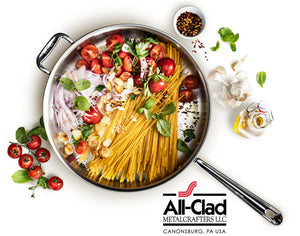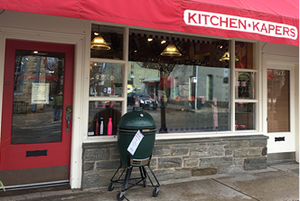
Psssst. Hey you. Yeah, you! Can we let you in on a little secret about "Non-Stick" Cookware?....
It doesn't last!
I mean, they all start out great and I guess if you knew all the Tricks for Making Nonstick Cookware Stay Nonstick, and if you were real careful about following them...sure it could last a pretty long while. But most home kitchens are lucky to get more than 5 years of half-decent performance out of our PTFE and Ceramic coated non-stick pans. And too often they're shot after just 2 years! What's a cook do to?!
Well, we're glad you asked. Take a lesson from the pros and get yourself a carbon steel pan. Commercial kitchens are entirely about functionality and efficiency, so most chefs stick with what they know works best- and costs less in the long run. And that's why carbon steel skillets have been a mainstay in professional kitchens since...well, forever!
Think of a carbon steel pan as the leaner, lighter cousin of the cast iron skillet; both share an unfinished, elemental quality that set them apart from the shiny stuff typically found in home kitchens. This no-nonsense cookware is pressed from raw, heavy-guage steel, making it one of the toughest and most durable pieces of cookware you can own. A simple, angled, slat-shaped steel long handle is designed for true commercial use and secured by at least two, but usually three brawny rivets. But if we're making it sound a bit like "super-pan" (and it is), then we have also have to admit that it has a "kryptonite":
Water.
Bare steel rusts when it's left wet or damp. Even moisture in the air can cause a light "flash-rusting" in just minutes. For that reason, brand new pans are typically coated in beeswax to protect the surface during shipping and marketing. Simply scrub the beeswax off under hot water, then rinse the pan well in cold water to avoid flash rusting before you begin the seasoning process.
The key that unlocks Carbon Steel's "super-pan" status, is "seasoning". Through this simple process, you can easily prevent rust, and develop outstanding nonstick properties. It's the same exact method used to season bare cast iron pans, ( Cast Iron Seasoning page ). Or, if you prefer, you can buy a pre-seasoned skillet, which undergoes a finishing process at the forge that's at least thorough enough to protect it from rust until you start cooking with it.
The picture below compares a forge-seasoned Lodge skillet (left) with a use-seasoned French skillet (right). The old French steel is smooth, shiny and exhibits very good non-stick performance. The forge-seasoned pan's visibly textured pre-seasoning will not be as nonstick as the French pan from the start, but it will get there soon. In fact, whether you choose to start with raw or forge-seasoned carbon steel cookware, as long as you cook with it and clean it properly, the seasoning patina will become increasingly smooth, dark and nonstick.

Once you have a well-seasoned carbon steel pan, there is little it can't do very well. Turn out flawless rolled omelets; sear a rib-eye to caramelized perfection; saute a juicy chicken picata; blacken catfish; roast brussel sprouts; bake a Tarte Tatin. Carbon steel is ridiculously versatile. It works well on every stove type, in the oven and under the broiler. It'll even stand up to the grill or campfire. And the best part? This is one non-stick pan that will never stop working for you. The heavy gauge steel construction is nearly indestructible, and if the nonstick patina is ever compromised by acidic foods or an over-zealous scrub, just season it again and you've got a brand new non-stick surface that keeps getting better with every use.
By the way...did we mention that carbon steel skillets can cost less than a lot of premium non-stick cookware? And we mean way less.
Just for fun, we tested an old-school technique for seasoning Carbon Steel pans (Yup- that's just one way we kick back).
It requires some odd "ingredients", but claims to season a bare steel pan in less than 15 minutes, versus the 2-4 hours required for the tried and true cast iron method, so we had to give it a try.
Our test pan was a well-used French carbon steel pan that was first purchased in 2000. It began its life doing professional work for a long-since-closed catering kitchen, before "migrating" with the chef to a local restaurant where it kept very busy for the next 10 years. But later, it ended up in storage, and while a well-developed seasoning patina kept the pan protected from rust, there was quite a bit of carbon build-up around the corners, rivets and handle.
We scrubbed the interior as clean as possible using BarKeeper's Friend and a scrubbie to start with the barest possible surface- the seasoning layers did not let go easily but we were able to strip most of it away from the interior surface. After a good rinse, the pan was set to dry over a medium-high fire before adding the following:
- 1/3 Cup of cooking oil (any type will do)
- 2/3 Cup of kosher salt
- Peels from 2 large potatoes
The method is: Cook over medium heat for 10-12 minutes, occasionally moving the peels around the pan and up the inside walls to the rim. Turn off the stove and once the pan is cool, discard the contents and wipe it out well with paper towels.

We followed the instructions carefully and came away with three valuable observations:
- We're not 100% sure what purpose the potato peels serve. But after about 8 minutes, they start to emit a most glorious aroma of fresh cut french-fries. So absolutely use them.
- This turned our pan a blotchy brown, but there's nothing uncommon or worrisome about that. In fact, it reminds us that seasoning is an ongoing process that turns cookware increasingly dark with every use, until it's absolutely black, like the best cast iron.
- It worked very well! The pan felt smooth enough, and when we tested it with a fried egg, it required just a small nudge with a spatula to get the egg slipping around the pan.
You can also check out our Cookware Cleaning Page to learn the best ways to clean carbon steel and other cookware types.




